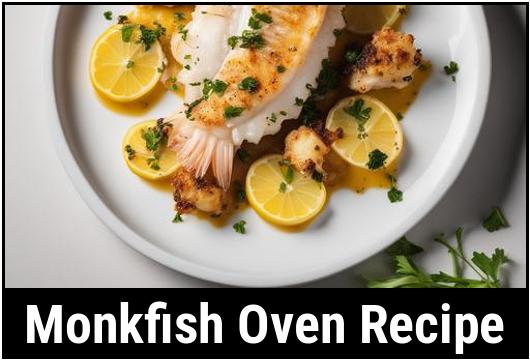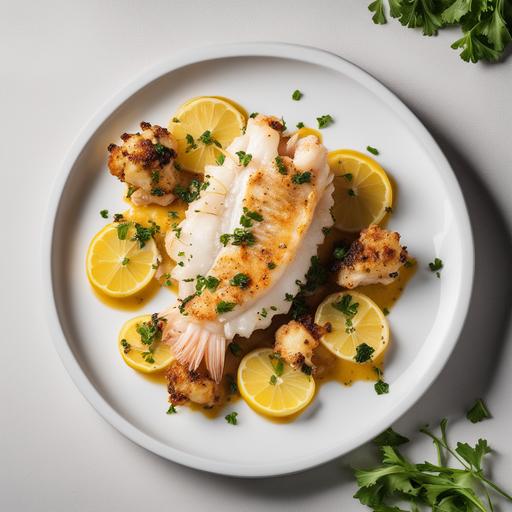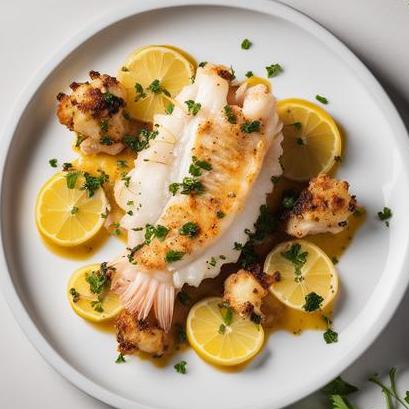
The Monkfish Oven Recipe: A Guide For Culinary Enthusiasts
Monkfish, known for its dense and meaty texture, is a delicacy cherished by seafood enthusiasts. Cooking monkfish in the oven presents a versatile method that retains its succulence while infusing it with delightful flavors. In this article, we delve into the science behind cooking monkfish in an oven, guide you through ingredient selection and preparation, discuss optimal cooking temperatures and timings, and provide a comprehensive monkfish oven recipe to elevate your culinary repertoire.
Monkfish, also referred to as "the poor man’s lobster," is a species prized for its firm flesh and mild, slightly sweet flavor. It’s commonly found in the North Atlantic and Mediterranean waters. When cooked properly, monkfish yields a texture reminiscent of lobster or scallops, making it a versatile ingredient in various culinary creations.
Cooking monkfish in an oven offers a convenient method that requires minimal hands-on time, allowing you to focus on preparing complementary side dishes or enjoying the company of your guests. By understanding the food science behind oven cooking, selecting high-quality ingredients, and following precise cooking techniques, you can ensure that your monkfish dish turns out tender, flavorful, and visually appealing.
Food Science Of Cooking Monkfish In An Oven
The process of cooking monkfish in an oven involves principles of heat transfer, protein denaturation, and flavor development. Understanding these concepts is crucial for achieving optimal results.
Heat Transfer
When monkfish is placed in a preheated oven, heat is transferred from the oven’s heating elements to the surface of the fish through convection. The outer layers of the monkfish cook first, forming a flavorful crust, while heat gradually penetrates towards the center. This slow and steady cooking process ensures that the monkfish cooks evenly without becoming dry or overcooked.
Protein Denaturation
Monkfish, like other types of fish, primarily consists of protein molecules. When subjected to heat, these protein molecules undergo denaturation, a process where their structure unravels and reorganizes. This structural change leads to the coagulation of proteins, resulting in firming of the flesh and the formation of a desirable texture.
Flavor Development
As the monkfish cooks in the oven, Maillard reactions occur on its surface. These reactions, which involve the browning of proteins and sugars, contribute to the development of complex flavors and aromas. Additionally, any seasoning or marinade applied to the monkfish enhances its taste profile, infusing it with layers of savory, sweet, or tangy notes.
Choosing Ingredients
Selecting fresh, high-quality ingredients is essential for preparing a delicious monkfish dish. When purchasing monkfish, look for the following indicators of freshness:
- Appearance: The flesh should be firm, moist, and free from any discoloration or strong odor.
- Texture: Press the flesh gently with your finger—it should spring back and not leave an indentation.
- Smell: Fresh monkfish should have a clean, mild odor reminiscent of the sea.
In addition to fresh monkfish, consider the following ingredients to enhance the flavor and presentation of your dish:
- Herbs: Fresh herbs such as parsley, thyme, or dill can add brightness and aroma to the dish.
- Citrus: Lemon or lime zest and juice provide acidity and freshness to balance the richness of the monkfish.
- Garlic: Minced or sliced garlic cloves impart savory depth to the dish.
- Olive Oil: High-quality olive oil adds richness and helps prevent the monkfish from drying out during cooking.
- Salt and Pepper: Season the monkfish generously with salt and pepper to enhance its natural flavors.
Preparing Ingredients

Proper preparation of the monkfish and accompanying ingredients is crucial for ensuring a successful oven-cooked dish. Follow these steps for optimal preparation:
Monkfish Preparation
- Trimming: Remove any membrane or connective tissue from the monkfish fillets using a sharp knife. This step ensures that the flesh cooks evenly and prevents toughness.
- Portioning: Cut the monkfish fillets into evenly-sized portions to promote uniform cooking. Aim for portions that are approximately 6-8 ounces each, depending on personal preference.
- Seasoning: Season the monkfish generously with salt and pepper, ensuring that the seasoning coats all sides of the fillets. Optionally, marinate the fillets in a mixture of olive oil, minced garlic, and herbs for added flavor.
Ingredient Preparation
- Herbs and Citrus: Rinse the fresh herbs and citrus thoroughly under cold water. Pat them dry with paper towels and finely chop the herbs. Zest the citrus using a microplane grater or zester, being careful to avoid the bitter white pith.
- Garlic: Peel and mince the garlic cloves. Alternatively, slice them thinly for a milder garlic flavor.
- Olive Oil: Measure out the desired amount of olive oil for both seasoning the monkfish and drizzling over the finished dish.
With the ingredients prepared and ready to go, you can proceed to the next step: cooking the monkfish in the oven.
Optimal Oven Cooking Temperature & Timing
Achieving the perfect balance of temperature and timing is crucial for cooking monkfish to perfection in the oven. Follow these guidelines for optimal results:
Oven Temperature
Preheat your oven to 375°F (190°C). This moderate temperature allows the monkfish to cook gently without drying out or becoming tough. Additionally, it promotes even browning on the surface while ensuring that the interior reaches the desired level of doneness.
Cooking Timing
The cooking time for monkfish fillets will vary depending on their thickness and the specific characteristics of your oven. As a general rule of thumb, aim for an approximate cooking time of 10-15 minutes per inch of thickness. Use a meat thermometer to check for doneness—the internal temperature of the monkfish should reach 145°F (63°C).
Keep in mind that monkfish is prone to overcooking, so it’s essential to monitor its progress closely and remove it from the oven as soon as it reaches the desired temperature. Allow the monkfish to rest for a few minutes before serving to allow the juices to redistribute and ensure optimal tenderness.
Monkfish Oven Recipe
Now that you’re familiar with the science and techniques behind cooking monkfish in the oven, let’s dive into a delicious recipe that showcases this versatile seafood:
Ingredients
- 4 monkfish fillets (6-8 ounces each)
- Salt and pepper to taste
- 2 tablespoons olive oil
- 2 cloves garlic, minced
- 1 tablespoon fresh parsley, chopped
- 1 lemon, zest and juice
Instructions
-
Preheat the Oven: Preheat your oven to 375°F (190°C) and position the rack in the center of the oven.
-
Prepare the Monkfish: Pat the monkfish fillets dry with paper towels and season them generously with salt and pepper on both sides.
-
Seasoning Mixture: In a small bowl, combine the olive oil, minced garlic, chopped parsley, lemon zest, and juice. Mix well to create a flavorful seasoning mixture.
-
Marinate the Monkfish: Drizzle the seasoning mixture over the seasoned monkfish fillets, ensuring that they are evenly coated. Allow the fillets to marinate for 10-15 minutes to absorb the flavors.
-
Arrange in Oven-safe Dish: Place the marinated monkfish fillets in an oven-safe dish or on a baking sheet lined with parchment paper, leaving space between each fillet for even cooking.
-
Bake in the Oven: Transfer the dish to the preheated oven and bake the monkfish for 12-15 minutes, or until the internal temperature reaches 145°F (63°C).
-
Rest and Serve: Remove the monkfish from the oven and let it rest for a few minutes before serving. Garnish with additional fresh parsley and lemon slices if desired. Serve hot and enjoy the succulent flavors of perfectly cooked monkfish.
Cooking monkfish in the oven is a simple yet elegant way to showcase the natural flavors and textures of this prized seafood. By understanding the principles of heat transfer, protein denaturation, and flavor development, you can achieve tender, flavorful monkfish fillets that are sure to impress your family and guests. With the comprehensive recipe provided in this article, you’re equipped with all the knowledge and techniques needed to master the art of monkfish oven cooking. Experiment with different seasonings, herbs, and accompaniments to create unique variations of this delectable dish and elevate your culinary repertoire.
Doneness Checks
Monkfish, often likened to the taste and texture of lobster, is a versatile fish that lends itself well to various cooking methods. Oven-baking monkfish is a simple yet effective way to preserve its delicate flavor and moist texture. This recipe is perfect for both novice and experienced cooks, as it requires minimal preparation and yields impressive results.
Before delving into the recipe, it’s essential to understand how to determine when monkfish is properly cooked. Unlike some other fish varieties, monkfish should be cooked until it reaches an internal temperature of 145°F (63°C). At this temperature, the flesh should appear opaque and easily flake with a fork. To ensure accuracy, consider using a meat thermometer inserted into the thickest part of the fish.
Undercooking
Undercooking monkfish can result in a rubbery texture and unpleasant taste. To avoid this, make sure to cook the fish until it reaches the recommended internal temperature of 145°F (63°C). If you’re unsure about the doneness, err on the side of caution and cook the fish for an additional few minutes until it flakes easily.
Overcooking
Overcooking monkfish can cause it to become dry and lose its delicate flavor. To prevent this, monitor the cooking time closely and avoid leaving the fish in the oven for longer than necessary. Remember that monkfish cooks relatively quickly, so check for doneness frequently to ensure it doesn’t become overcooked.
Troubleshooting
If you encounter any issues while preparing this oven-baked monkfish recipe, here are some troubleshooting tips to help you overcome common challenges:
- Dry Fish: If the monkfish turns out dry, it may have been overcooked. To salvage it, consider serving it with a sauce or broth to add moisture and flavor.
- Undercooked Fish: If the fish is undercooked, return it to the oven and continue cooking until it reaches the desired internal temperature.
- Uneven Cooking: To ensure even cooking, consider cutting the monkfish into uniform-sized pieces before baking. This will help ensure that all pieces cook at the same rate.
Recipe Variations

While the basic oven-baked monkfish recipe is delicious on its own, you can customize it to suit your taste preferences. Here are some variations to consider:
Lemon Herb Monkfish
- Marinate the monkfish in a mixture of lemon juice, olive oil, minced garlic, and chopped fresh herbs such as parsley, thyme, and rosemary.
- Bake the fish as directed, brushing with the marinade halfway through cooking for added flavor.
Spicy Monkfish
- Create a spicy rub using paprika, cayenne pepper, garlic powder, onion powder, and salt.
- Coat the monkfish fillets with the spice rub before baking for a fiery kick.
Mediterranean Style Monkfish
- Top the monkfish with a mixture of chopped tomatoes, olives, capers, and fresh herbs such as basil and oregano.
- Drizzle with olive oil and bake until the fish is cooked through and the topping is slightly caramelized.
Asian-Inspired Monkfish
- Marinate the monkfish in a mixture of soy sauce, ginger, garlic, and sesame oil.
- Garnish with sliced green onions and sesame seeds before serving for an Asian twist.
Oven-baking monkfish is a simple yet flavorful way to enjoy this versatile seafood. By following the tips and variations outlined in this guide, you can create a delicious monkfish dish that will impress your family and friends. Whether you prefer it seasoned with herbs and lemon or spiced with bold flavors, monkfish is sure to become a favorite in your culinary repertoire.
Flavour Enhancement Tips
Monkfish, known for its firm texture and mild, slightly sweet flavor, is a versatile and delicious fish that lends itself well to various cooking methods.
To enhance the flavor of monkfish, it’s crucial to start with fresh, high-quality ingredients. When selecting monkfish, look for firm, translucent flesh with a mild aroma of the sea. Additionally, consider marinating the monkfish before cooking to infuse it with additional flavor.
A simple marinade can be made by combining olive oil, lemon juice, minced garlic, fresh herbs such as thyme or rosemary, salt, and pepper. Allow the monkfish to marinate for at least 30 minutes, or preferably overnight, in the refrigerator to allow the flavors to penetrate the flesh fully.
Texture Enhancement Tips
Monkfish has a naturally firm texture that holds up well to various cooking methods, including roasting in the oven. To enhance the texture of the monkfish, consider wrapping it in bacon or prosciutto before cooking. This not only adds flavor but also helps to keep the fish moist and tender during cooking.
Another technique to enhance the texture of monkfish is to sear it briefly in a hot skillet before transferring it to the oven. Searing creates a caramelized crust on the outside of the fish, adding depth of flavor and a pleasing texture contrast.
Cooking At Different Temperatures
When cooking monkfish in the oven, it’s essential to consider the temperature and cooking time to ensure that the fish cooks evenly and retains its moisture. A moderate oven temperature of around 375°F (190°C) is ideal for cooking monkfish, as it allows the fish to cook through gently without drying out.
For a perfectly cooked monkfish, aim for an internal temperature of 145°F (63°C) when measured with a meat thermometer inserted into the thickest part of the fish. Cooking times will vary depending on the thickness of the monkfish fillets or steaks, but as a general guideline, plan for approximately 15-20 minutes per inch of thickness.
Cooking Tips
To prepare monkfish for cooking in the oven, start by preheating the oven to 375°F (190°C). If marinating the monkfish, remove it from the refrigerator and allow it to come to room temperature for about 15 minutes before cooking.
While the oven is preheating, pat the monkfish dry with paper towels to remove any excess moisture. This will help the fish to brown evenly during cooking.
If wrapping the monkfish in bacon or prosciutto, carefully wrap each piece of fish with a slice of bacon or prosciutto, securing it with toothpicks if necessary.
Once the oven is preheated, place the monkfish on a lightly greased baking sheet or in a baking dish, making sure to space the pieces apart to allow for even cooking.
Roast the monkfish in the preheated oven for 15-20 minutes, or until it is cooked through and flakes easily with a fork. If desired, you can baste the monkfish with any remaining marinade or pan juices halfway through the cooking process to keep it moist and flavorful.
Serving Suggestions
Once the monkfish is cooked to perfection, remove it from the oven and allow it to rest for a few minutes before serving. This allows the juices to redistribute throughout the fish, ensuring that each bite is tender and succulent.
Monkfish pairs well with a variety of side dishes, including roasted vegetables, steamed greens, or a simple salad. For a complete meal, consider serving the monkfish with a flavorful sauce, such as a lemon-butter sauce, salsa verde, or a tangy tomato relish.
Garnish the monkfish with fresh herbs, such as parsley or chives, for a pop of color and added freshness. And don’t forget to serve it with plenty of crusty bread or rice to soak up any delicious sauces or juices.
Conclusion
In conclusion, monkfish is a versatile and delicious seafood that can be easily prepared in the oven for a flavorful and satisfying meal. By following these tips and techniques, you can enhance the natural flavors and textures of monkfish and create a dish that is sure to impress family and friends alike.
Whether you’re hosting a dinner party or simply craving a gourmet meal at home, this monkfish oven recipe is sure to become a favorite in your culinary repertoire. So don your apron, fire up the oven, and get ready to enjoy a mouthwatering meal that celebrates the best of what the sea has to offer.
FAQS
What Is A Monkfish Oven Recipe?
A monkfish oven recipe is a cooking method that involves baking or roasting monkfish in the oven to achieve a flavorful and tender dish.
How Long Does It Take To Cook Monkfish In The Oven?
The cooking time for monkfish in the oven depends on the size and thickness of the fish. As a general guideline, it typically takes around 15-20 minutes per inch of thickness at a temperature of 400°F (200°C).
What Ingredients Do I Need For A Monkfish Oven Recipe?
The main ingredients typically used in a monkfish oven recipe are monkfish fillets, olive oil, salt, pepper, and additional seasonings of your choice such as garlic, lemon zest, or herbs like thyme or rosemary. You may also include vegetables like cherry tomatoes or asparagus to enhance the flavor and presentation.
How Do I Prepare Monkfish For Baking In The Oven?
Before baking monkfish in the oven, you should rinse the fillets under cold water and pat them dry with paper towels. If desired, remove any translucent membrane or dark membrane from the fillets as they can lend a slightly chewy texture. You can then season the fish with salt, pepper, and any other desired seasonings.
What Is The Recommended Internal Temperature For Cooked Monkfish?
The recommended internal temperature for cooked monkfish is 145°F (63°C). This can be measured using a food thermometer inserted into the thickest part of the fish. It is important to ensure that the fish is fully cooked to promote safety and optimal taste.


